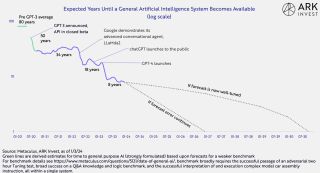Artificial Intelligence
The Accelerating Path to Artificial General Intelligence
The success of LLMs is reframing our expectations.
Updated January 5, 2024 Reviewed by Tyler Woods
Key points
- GPT advancements signal profound cross-industry impacts and increased AI sophistication.
- AGI's imminent reality calls for immediate ethical and societal preparation to guide its integration.
- ARK Invest's graph depicts a rapid approach toward AGI, accelerated by GPT-3 and GPT-4 developments.

Quick, name three letters that have captured our imaginations. From acronyms to the Devine, there's one term that has conjured both fear and excitement: AGI or Artificial General Intelligence.
A new chart from ARK Invest captures our collective gaze and evolving expectations. The once-distant dream of AGI—machines endowed with the broad cognitive capabilities of the human mind—seems to be drawing closer with a pace that is both exhilarating and, for some, unnerving. The graph showcases a timeline not just of advancements but of our expectations, and how they've contracted from a leisurely stroll to a sprint. Of course, the very definition of AGI itself may also be part of this perceptual shift.
The Exponential Leap
In the early 2020s, the arrival of AGI was a speculative conversation to be had over decades. Fast forward, and each leap—from GPT-3's announcement to the unveiling of GPT-4 and other LLMs—has carved chunks off the countdown to AGI. The graph reflects this with a steep decline in the expected years until AGI's emergence. It's not merely progress; it's progress at an accelerated clip and, in ways, aligns with the exponential path that is commonly seen with disruptive innovation.
The GPT Effect
The role of GPT and other large language models in this shift cannot be overstated. With GPT-3, we saw potential; with GPT-4, we saw prowess. Each iteration has served as a proof point, demonstrating AI's growing fluency in the language of human thought. The implications have rippled—or dare I say ripped—through industries, inspiring transformations in healthcare, finance, education, and more.
A Tale of Two Trajectories
ARK's graph delineates two trajectories from our present vantage point: one where the forecast for AGI remains optimistic and "well-tuned," and another where the "forecast error continues," implying a possible plateau in advancements. The former suggests a world imminently reshaped by AGI, while the latter cautions us against overconfidence in a smooth ascent. Nevertheless, the shift in expectations is remarkable.
Facing the Challenges Ahead
As we slide down the path towards AGI, we must also brace for its implications. AGI potentially brings a cornucopia of ethical, societal, and existential questions. Can we ensure that AGI aligns with human values? How do we navigate the likely displacement in the workforce? What governance structures do we need? The path to AGI is as much about the answers to these questions as it is about the technology itself.
Refocus and Reprioritization
This graph is not a mere predictor; it's a call to action for policymakers, technologists, ethicists, and society at large. As we harness the winds of AI's capabilities, we must also steer the ship with a steady hand, ensuring that our journey toward AGI is one that remains anchored to our shared human interests.
The message is clear: AGI is on the horizon, closer than we ever imagined. It's time for us to prepare—not just for the technology, but for the world it will help create. The future is not just something to predict, but something to shape. And as we stand at the forefront of this new era, we must all be active participants in molding a future where AGI amplifies our humanity rather than diminishes it.


